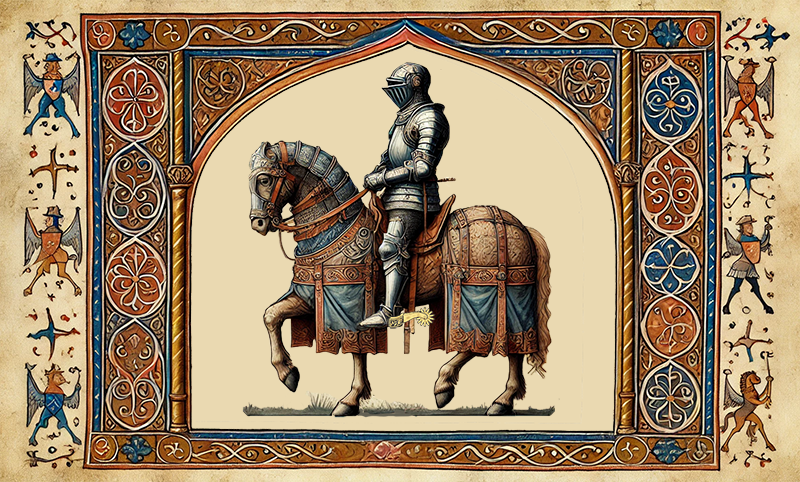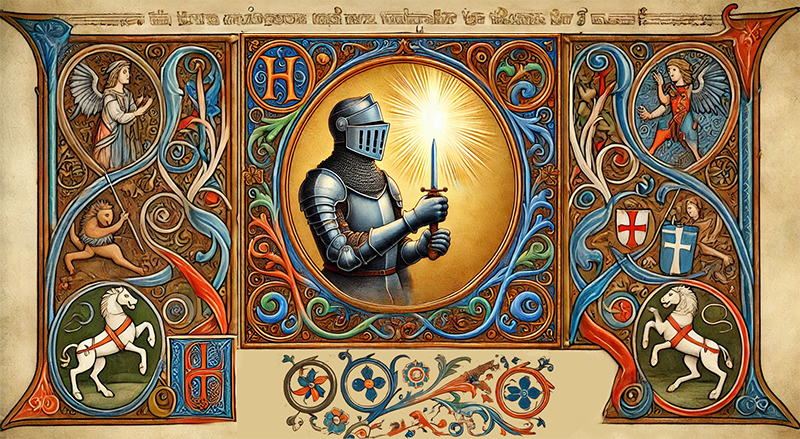The Book of the Order of Chivalry (c. 1275), was written by Ramon Llull (1232–1315), a polymath and Christian mystic from Majorca. Llull thought that knights should be chosen, trained, and ordained like priests. Llull’s book became a handbook of chivalry throughout much of Europe. Being a Christian mystic, of course he writes about Chivalry using Christian vocabulary. But I think his ideas transcend any particular Spiritual Tradition.
Llull wrote over 250 books on a wide range of subjects, including theology, philosophy, logic, science, and even poetry. (And one on Chivalry!) He is best known for his book Ars Magna — a groundbreaking philosophical and logical system that aimed to uncover universal truths using mathematics — now considered the invention of Mathematical Combinatorics. He was also known for his interest in memory and logical systems more generally: his method of linking virtues to physical objects is an example of the ancient memory technique known as the Memory Palace.
An overview of the Order of Chivalry, and a linked table of contents to all my blogs (with music) on various chapters of Llull’s book can be found HERE.

Here Llull equates the spurs with ‘perseverance’:
Spurs are given to the knight to signify perseverance and zeal, because with these two things every knight may maintain his Order in the high honor that belongs to it. For in the same way that he pricks the horse with the spurs so that it hastens to run, likewise does diligence hastens him to do his duty, and makes him to procure the harness and the provisions that are needful to a knight, to the end that a man not be surprised nor taken suddenly.
Llull’s comparison of the knight’s spurs to perseverance and zeal highlights the importance of continual effort and determination in upholding the ideals of Chivalry. Just as the spurs drive the horse forward, perseverance pushes the knight to fulfill his duties with diligence and readiness. Llull emphasizes that perseverance is essential for maintaining the honor of the Order of Chivalry, ensuring that the knight remains vigilant and prepared for whatever challenges arise.
“Spurs are given to the knight to signify perseverance and zeal.”
Llull connects the spurs, tools used to prompt the horse to move forward, to the virtues of perseverance and zeal. Perseverance is the constant drive to continue striving toward one’s goals, regardless of obstacles or fatigue. Zeal is the passion and enthusiasm that fuels this effort. Llull reminds us that a knight’s journey is not easy, and it is through these qualities that a knight remains committed to his duties. This idea resonates across spiritual traditions, where perseverance is often seen as key to personal growth and spiritual fulfillment. In Christianity, for example, perseverance is essential to enduring trials and staying faithful to one’s calling, while in Buddhism, perseverance in practice leads to enlightenment.
“For in the same way that he pricks the horse with the spurs so that it hastens to run.”
Just as the spurs prompt the horse to move forward quickly and with purpose, perseverance drives the knight to take action. Llull’s metaphor suggests that perseverance is not passive; it is an active force that pushes the knight to fulfill his responsibilities with speed and efficiency. The knight does not wait for challenges to come to him—he meets them head-on, driven by his inner zeal. This proactive approach to duty is reflected in many traditions. In Stoicism, for example, perseverance is seen as an essential virtue that enables individuals to confront adversity with resilience and determination.
“Diligence hastens him to do his duty.”
Perseverance is closely tied to diligence, the careful and persistent effort to accomplish one’s responsibilities. Llull emphasizes that perseverance ensures that the knight does not become complacent or neglectful. Instead, he is diligent in carrying out his duties, always seeking to fulfill the expectations of his role. This echoes the idea found in many spiritual traditions that perseverance is not just about enduring hardship but about actively working toward one’s goals with dedication. In Confucianism, the concept of li (ritual propriety) reflects the importance of diligence in fulfilling one’s societal and moral responsibilities, ensuring that every action is carried out with care and attention.
“Procure the harness and the provisions that are needful to a knight.”
Perseverance also involves preparation. Llull highlights that the knight must gather the necessary tools and provisions to be ready for any situation. This preparation ensures that the knight is never caught off guard or unprepared, reflecting the broader idea that perseverance includes the foresight to anticipate challenges and the diligence to prepare for them. In spiritual terms, this is akin to the practice of cultivating the necessary skills and virtues to face life’s trials. In the Taoist tradition, wu wei (effortless action) suggests that preparation allows one to move through life’s challenges with ease, as readiness and perseverance enable graceful responses to adversity.
“To the end that a man not be surprised nor taken suddenly.”
Finally, Llull emphasizes that perseverance allows the knight to avoid being caught off guard. Through consistent effort and preparation, the knight ensures that he is always ready for whatever may come. This vigilance is a key aspect of perseverance—remaining alert and proactive, rather than reactive, in the face of challenges. In many spiritual traditions, perseverance includes the cultivation of mindfulness and awareness, ensuring that one is always prepared for the unexpected. In Buddhism, for instance, the practice of sati (mindfulness) allows individuals to remain present and alert, ready to respond skillfully to whatever arises.
In conclusion, Llull’s metaphor of the knight’s spurs as perseverance reflects the vital role of consistent effort, diligence, and readiness in the life of a knight. Just as the spurs drive the horse forward, perseverance pushes the knight to fulfill his duties with zeal and purpose, ensuring that he is prepared for any challenge. Across spiritual traditions, perseverance is seen as a key virtue, essential for maintaining focus, overcoming obstacles, and achieving one’s goals. Llull’s vision reminds us that perseverance is not simply about enduring hardship—it is an active force that drives us to remain diligent, prepared, and committed to our responsibilities, ensuring that we meet life’s challenges with strength and resolve.
YouTube











